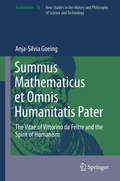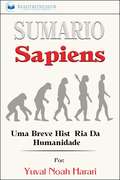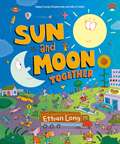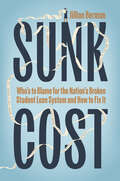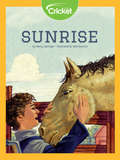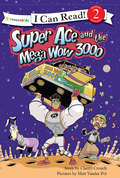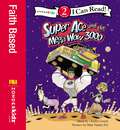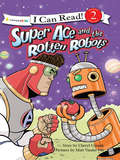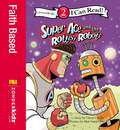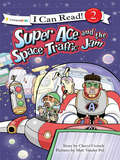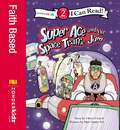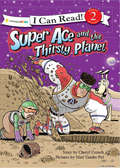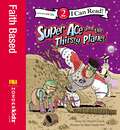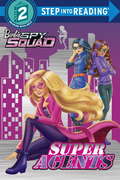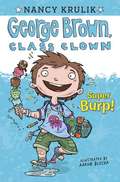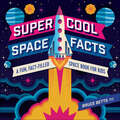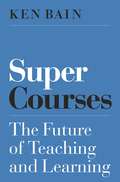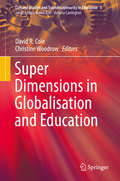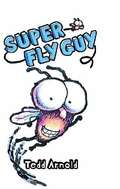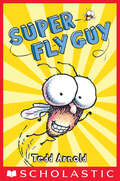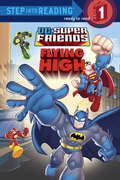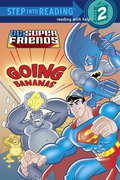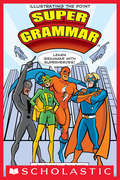- Table View
- List View
Summus Mathematicus et Omnis Humanitatis Pater
by Anja-Silvia GoeingThis book revises the picture of the teacher and educator of princes, Vittorino Rambaldoni da Feltre (c. 1378, Feltre -- 1446, Mantua), taking a completely new approach to show his work and life from the individual perspectives created by his students and contemporaries. From 1423 to 1446, Vittorino da Feltre was in charge of a school in Mantua, where his students included not only the offspring of Italy's princes, but also the first generation of authors dealing with books in print. Among his students were historians like Bartolomeo Sacchi (named Platina), who wrote an extensive history of the popes, and mathematicians like Jacopo Cassiano (Cremonensis), who translated the work of Archimedes from Greek into Latin. Vittorino is still regarded as the educationalist of Italian Renaissance humanism per sé. This work not only contributes to the study of the history of Italian humanist institutions, it also uses available sources to demonstrate the development of a new attitude to education in Italy.
Sumário de Sapiens: Uma Breve História da Humanidade
by Readtrepreneur PublishingSumário do Livro Sapiens: Uma Breve História da Humanidade de Yuval Noah Harari Como conseguimos chegar tão longe? Nós, os Homo sapiens, dominamos o mundo porque somos o único animal que acredita no poder da imaginação. Escrito pelo Dr. Yuval Noah Harari, Sapiens é uma obra-prima verdadeiramente única. Enquanto outros livros têm como tópicos principais somente a parte histórica ou biológica dos seres humanos, “Sapiens” destaca as três grandes revoluções da história da humanidade: a Revolução Cognitiva, a Revolução Agrícola e a Revolução Científica. “Não existe nenhuma coisa que seja verdade. Tudo é verdade” – Yuval Noah Harari O Dr. Harari agora nos aconselha a pensar no futuro porque as coisas estão mudando. Está provado que nós, seres humanos, não apenas revolucionamos o mundo, mas também as nossas vidas. Nós nos desenvolvemos, nós nos aperfeiçoamos e nós nos transformamos. E esta transformação vai continuar acontecendo. Aonde ela vai nos levar? Aonde vamos chegar? Em que estamos nos transformando? (Observação: Este sumário foi integralmente escrito e publicado pela readtrepreneur.com. Ele não tem nenhuma ligação com o livro original do autor) P.S. Enriqueça o seu cérebro de sabedoria e conhecimento com este livro. Descubra que você é muito mais do que realmente pensa que é. Você vai gostar muito deste livro. Afinal, você é um ser humano. Chega de pensar! É hora de agir! Clique no botão “Buy now with 1-Click” e receba uma cópia imediatamente! Por que escolher a Readtrepreneur? Resumos de alta qualidade Garantia de incríveis conhecimentos Atualizações fantásticas Clareza e precisão Isenção de responsabilidade: Este livro destina-se a ser um excelente guia do livro original ou apenas uma síntese do livro original. Se você procura pelo livro original, clique no seguinte link: http://amzn.to/2qxORbB
Sun and Moon Together: Happy County Book 2 (Happy County #2)
by Ethan LongSun and Moon Together is a vibrant, graphic picture book compendium for preschoolers set in a Richard Scarry-inspired environment by Geisel Award-winning creator Ethan Long.Welcome to another busy day in Happy County! The Sun is out and shining down on lots of friends. Grammy Tammy from Miami is doing grimey, slimey laundry. Sssonny Sssnakerton wants to grow sssunflowers. And when the Sun says goodbye for the day, the Moon pops up for a new set of adventures. Now Molly and her mom can make moon shadows and howl night noises. This 48-page full-color primer is chock-full of charming characters and basic scientific concepts connected to the sun and the moon presented in simple, accessible terms for the young audience, touching on: the water cycle, phases of the moon, the solar system, and plenty of clever scenarios to keep little ones engaged. Happy County#1 Hello, World!#2 Sun and Moon TogetherChristy Ottaviano Books
Sundancer
by Shelley PetersonFrom the outside, 13-year-old Alberta-- aka Bird-- looks like a typical teenager. She spends her days attending school, riding horses and helping out on the farm where she lives with her Aunt Hannah. But Bird is anything but typical.
Sunk Cost: Who’s to Blame for the Nation’s Broken Student Loan System and How to Fix It
by Jillian BermanExposes the forgotten origins of the student loan system, how politicians have attempted to fix it, and the life-altering damage borrowers face. Student-loan horror stories are a dime a dozen. But students today are faced with a seemingly insurmountable paradox: Research consistently shows that the clearest viable option to financial stability is a college degree. But if and when Americans decide to pursue diplomas, student loan payments quickly follow, and even after securing full-time employment, many borrowers struggle to make ends meet for years. In Sunk Cost, journalist Jillian Berman explores how the nation’s student loan program went from a well-intentioned initiative aimed at helping low- and middle-income students afford college to one that traps borrowers in long-term debt. Berman interviewed dozens of borrowers and policymakers and dug into the archives to unearth the true causes of the student loan problem. A couple of generations ago, policy makers generously subsidized Americans’ college educations because they knew it would be advantageous for the entire country: a more educated population meant better quality of life for all. But today, higher education is viewed as an individual goal, so students and their families are expected to be on the hook for it themselves. Berman explains how this enormous shift happened, which industries benefit from it, and what it means for college-going Americans today. She shares real-life stories of college graduates who are being crushed under some of the harshest consequences of the student loan system. These borrowers pursued higher education in hopes of a better life and yet some have been trapped in debt for decades, making it difficult to put food on the table, much less imagine a life beyond debt. By connecting personal accounts to the policy history of student loans, Berman makes clear that if American society continues to push students toward higher education, but fails to truly subsidize it, the financial strain will become unbearable for all but the most privileged. The current system is broken, but Berman proposes that significant changes are possible, and will require political will from state lawmakers and Congress, along with a philosophical shift, to tackle one of the largest consumer finance challenges of our time.
Sunrise
by Nancy SpringerMike doesn’t want to learn to ride horses! He is content trying to show everyone that not all kids in wheelchairs are nice, but his physical therapist wants him to try horseback riding to help strengthen his legs. Will Liverwurst the horse help him develop a different attitude towards his disability?
Super Ace and the Mega Wow 3000 (I Can Read! #Level 2)
by Cheryl CrouchSpace hero Super Ace is called to planet Floop because the Mega Wow 3000, a spaceship loaded with food for hungry children, will not go. Super Ace tries to use his super powers, (strength and good looks) to fix the ship. With his big arms, he bends and lifts and moves the Mega Wow. Pieces of the Mega Wow snap and pop, but the ship still will not work. When the ship’s owner turns to Sidekick Ned, Super Ace laughs. But Ned uses his God-given wisdom to find the key that turns on the ship. Now the hungry children will get their food! This level-two I Can Read book uses engaging characters and a simple plot to build children’s confidence as they discover the joy of reading independently.
Super Ace and the Mega Wow 3000: Level 2 (I Can Read! / Superhero Series)
by Cheryl Crouch Matt Vander PolA Lesson in Letting Your Light Shine.Hungry children are waiting for food packed in the Mega Wow 3000. But the spaceship will not go. Can Super Ace use his superpowers to fix the ship? Could Ned help?This is a Level Two I Can Read! book, which means it&’s perfect for children learning to sound out words and sentences. It aligns with guided reading level I and will be of interest to children Pre-K to 3rd grade
Super Ace and the Rotten Robots (I Can Read! #Level 2)
by Cheryl CrouchSpace hero Super Ace is called to planet Roop because the planet’s robots are making messes, being mean, and ruining everything. The planet is in chaos! Super Ace tries to use his super powers (strength and good looks) to make the robots obey him, but no matter what he tries, the robots are still bad. The planet leader turns to sidekick Ned, and Super Ace laughs. But Ned uses his God-given wisdom to discover that the main switch at Robot Control has been bumped. The lever that should point to Good now points to Bad. That’s why the robots are bad. They can’t choose how to act, like people can. Ned moves the lever to Good, and the robots begin to clean up the mess and help people again. This level-two I Can Read book uses engaging characters and a simple plot to build children’s confidence as they discover the joy of reading independently.
Super Ace and the Rotten Robots: Level 2 (I Can Read! / Superhero Series)
by Cheryl Crouch Matt Vander PolSpace hero Super Ace is called to planet Roop because the planet&’s robots are making messes, being mean, and ruining everything. The planet is in chaos! Super Ace tries to use his super powers (strength and good looks) to make the robots obey him, but no matter what he tries, the robots are still bad. The planet leader turns to sidekick Ned, and Super Ace laughs. But Ned uses his God-given wisdom to discover that the main switch at Robot Control has been bumped. The lever that should point to Good now points to Bad. That&’s why the robots are bad. They can&’t choose how to act, like people can. Ned moves the lever to Good, and the robots begin to clean up the mess and help people again. This level-two I Can Read book uses engaging characters and a simple plot to build children&’s confidence as they discover the joy of reading independently.
Super Ace and the Space Traffic Jam (I Can Read! #Level 2)
by Cheryl CrouchSpace hero Super Ace is called to planet Joop to fix a galactic space traffic jam. He and Sidekick Ned can’t even get to the planet because there are wrecks everywhere. Super Ace tries to use his super powers (strength and good looks) to clear the traffic and get everyone moving again, but his attempts only make the situation worse. Ned uses his God-given wisdom to solve the traffic problem. The galactic space stop light is flashing every color of the rainbow, so space ship drivers don’t know if they should go, slow down, or stop. He knows people have to follow the rules to be safe. Ned fixes the light and the drivers stop crashing. This level-two I Can Read book uses engaging characters and a simple plot to build children’s confidence as they discover the joy of reading independently.
Super Ace and the Space Traffic Jam: Level 2 (I Can Read! / Superhero Series)
by Cheryl Crouch Matt Vander PolA Lesson in Following Rules.Super Ace is needed on planet Joop! But he&’s stuck in an outer space traffic jam, where superpowers don&’t help. Sidekick Ned isn&’t strong or good-looking—but he might have the answer.This is a Level Two I Can Read! book, which means it&’s perfect for children learning to sound out words and sentences. It aligns with guided reading level I and will be of interest to children Pre-K to 3rd grade.
Super Ace and the Thirsty Planet (I Can Read! #Level 2)
by Cheryl CrouchSpace hero Super Ace is called to planet Woop because the main river has dried up. No one can drink or bathe, and they are cranky and smelly. Super Ace tries to use his super powers (strength and good looks) to find a way for the people to smell better and not be so thirsty. Nothing he tries works. The planet leader turns to Sidekick Ned, but Super Swish laughs. Ned uses his God-given wisdom to discover that a huge boulder has fallen into the river and blocked the water. Super Ace feels bad until Ned asks him to help by moving the large rock. Super Ace and Sidekick Ned are glad they have worked together. This level-two I Can Read book uses engaging characters and a simple plot to build children’s confidence as they discover the joy of reading independently.
Super Ace and the Thirsty Planet: Level 2 (I Can Read! / Superhero Series)
by Matt Vander PolA Lesson in Cooperation.Planet Woop is out of water. Everyone is thirsty and smelly. When superpowers don&’t work, Ned has an idea. But he can&’t do it alone. Will Super Ace help?This is a Level Two I Can Read! book, which means it&’s perfect for children learning to sound out words and sentences. It aligns with guided reading level I and will be of interest to children Pre-K to 3rd grade.
Super Agents (Barbie Spy Squad)
by Melissa LagonegroChildren ages 4 to 6 will love this deluxe Step 2 Step into Reading leveled reader based on Barbie's latest movie, releasing in spring 2016. Step 2 Readers use basic vocabulary and short sentences to tell simple stories. For children who recognize familiar words and can sound out new words with help.
Super Burp! (George Brown, Class Clown Book #1)
by Nancy KrulikGeorge Brown, Class Clown How much trouble can a burp get you into? A lot, if the burp is a magic one that makes you do wild and crazy stuff. Ask George what's new in his life and he'll tell you just about everything. His family has moved to a new town, far from all his friends in the Katie Kazoo, Switcheroo series. He's at a new school with new kids and a new teacher. He's even taken a new name--George Brown. Plus, George is trying hard to turn over a new leaf. No more pranks or clowning around. Will he succeed or will those crazy magic burps keep landing him in trouble? Watch for more books in the George Brown, Class Clown series! George Brown, Class Clown Trouble Magnet
Super Companion 5 In 1 Arthasastra 1st Puc: ಸೂಪರ್ ಕಂಪ್ಯಾನಿಯನ್ 5 ಇನ್ 1 ಅರ್ಥಶಾಸ್ತ್ರ 1st PUC NCERT ಹೊಸಪಠ್ಯ ಕ್ರಮದ ಪ್ರಸ್ತೋತ್ತರ ಮಾಲಿಕೆ
by Vidyasagar M. Aಸೂಪರ್ ಕಂಪ್ಯಾನಿಯನ್ 5 ಇನ್ 1 ಪ್ರಸ್ತೋತ್ತರ ಮಾಲಿಕೆ ಅರ್ಥಶಾಸ್ತ್ರ ಕನ್ನಡ ಮಾಧ್ಯಮ 1ST PUC ಪ್ರಶ್ನೋತ್ತರ ಮಾಲಿಕೆಯಾಗಿದ್ದು. ಇದು 1ST PUC ವಿದ್ಯಾರ್ಥಿಗಳಿಗೆ ಶೈಕ್ಷಣಿಕ ಸಂಪನ್ಮೂಲವಾಗಿದೆ.
Super Cool Space Facts: A Fun, Fact-Filled Space Book for Kids
by Bruce BettsDiscover a universe of fun and amazing facts about space for kids 6 to 9 Take an exciting, fact-filled journey that goes where all great space books for kids should—to our solar system and beyond! Super Cool Space Facts is bursting with info about stormy planets, exploding stars, weird black holes, amazing landers, and more.Blast past other space books for kids with:Galaxies of wonder—Launch into learning with awesome and easy-to-digest facts about everything from asteroids hurtling through space to astronauts on the International Space Station.Entertaining information—Fill your outer space adventure with the jokes, big word alerts, and fascinating mysteries of the universe all space books for kids should have.Full-color photos—See how cool space is with incredible pictures of stars, galaxies, planets, constellations, and more.Super Cool Space Facts brings you out-of-this-world fun—and a must have title for anyone interested in space books for kids.
Super Courses: The Future of Teaching and Learning (Skills for Scholars)
by Ken BainFrom the bestselling author of What the Best College Teachers Do, the story of a new breed of amazingly innovative courses that inspire students and improve learningDecades of research have produced profound insights into how student learning and motivation can be unleashed—and it’s not through technology or even the best of lectures. In Super Courses, education expert and bestselling author Ken Bain tells the fascinating story of enterprising college, graduate school, and high school teachers who are using evidence-based approaches to spark deeper levels of learning, critical thinking, and creativity—whether teaching online, in class, or in the field.Visiting schools across the United States as well as in China and Singapore, Bain, working with his longtime collaborator, Marsha Marshall Bain, uncovers super courses throughout the humanities and sciences. At the University of Virginia, undergrads contemplate the big questions that drove Tolstoy—by working with juveniles at a maximum-security correctional facility. Harvard physics students learn about the universe not through lectures but from their peers in a class where even reading is a social event. And students at a Dallas high school use dance to develop growth mindsets—and many of them go on to top colleges, including Juilliard. Bain defines these as super courses because they all use powerful researched-based elements to build a “natural critical learning environment” that fosters intrinsic motivation, self-directed learning, and self-reflective reasoning. Complete with sample syllabi, the book shows teachers how they can build their own super courses.The story of a hugely important breakthrough in education, Super Courses reveals how these classes can help students reach their full potential, equip them to lead happy and productive lives, and meet the world’s complex challenges.
Super Dimensions in Globalisation and Education
by David R. Cole Christine WoodrowThis volume is the first major production of the globalisation research strand of the Centre for Educational Research at Western Sydney University. This book makes a significant contribution to the theory of and research in globalisation and education, and tackles the topics of superdiversity and supercomplexity. The book's thesis is that the effects of globalisation on education can only be understood if the specific yet complex conditions of globalisation in education are investigated. The book takes an international approach to understanding globalisation and does not restrict itself to just one methodological or theoretical plane of investigation. Education is one ofthese frontline domains in which the effects of superdiversity cannot bedismissed, minimized or denied. The continuously increasing complexity oflearning environments is raising critical issues at every level, fromdescription over analysis to theoretical generalization, and this book is afirst and fruitful attempt at charting these waters. This pioneering book will remaina key text for many years to come. Jan Bloomaert Professor of Language,Culture and Globalization and Director of the Babylon Center Tilburg University,the Netherlands. This provocativecollection works from two premises: thattoday there is superdiversity in our globalised world and related is asupercomplexity of theoretical and methodological approaches. The collection proffers multifariouschallenges for educational theory, research and practice in working with,through and across these two premises. As such, SuperDimensions in Globalisation and Education is essential reading for all educational researchers, whatever theirinterests or location. Professor Bob Lingard The University ofQueensland, Australia. This is a highlyimaginative book that stops 'flat earth' and convergence arguments dead intheir tracks. Its genius is to bringsuper-complexity and super-diversity into a conversation with each other andwith education, and in doing so shed light on the numerous and unexpectedways in which global processes are shaping education in revealing andcompelling ways. Any scholar concerned with globalisation andeducation will find Super Dimensions in Globalisation and Education a' musthave' on their reading list. Professor Susan Robertson Director of the Centrefor Globalisation, Education and Social Futures University of Bristol,UK. This is an absorbingand compelling collection. It takes readers on a kaleidoscopic journey throughvarious intricate expressions of the nexus between globalisation andeducation. And it offers multiple waysthat such expressions can be thought and rethought. In transcending conventional categorisations it invites educators to doso too. Professor Jane Kenway, AustralianProfessorial Fellow - Australian Research Council, Education Faculty,Monash University, Australia.
Super Fly Guy (Fly Guy #2)
by Tedd ArnoldFLY GUY is off to school. Will he make trouble? Or will he save the day? A funny story by bestselling author and illustrator Tedd Arnold.
Super Fly Guy! (Fly Guy #2)
by Tedd ArnoldWill Fly Guy make trouble at school, or will he save the day?Fly Guy loves the school lunchroom. He loves the dirty dishes, the smelly mop, and the garbage cans. But when the lunch ladies discover there's a fly in the cafeteria, chaos ensues! Though Fly Guy makes a mess of things, he also shows his powers as a Super Fly Guy!Using hyperbole, puns, slapstick, and silly drawings, Tedd Arnold delivers an easy reader that is full of fun in his NEW YORK TIMES bestselling Fly Guy series.
Super Friends: Flying High (DC Super Friends) (Step into Reading)
by Random House Dc ComicsSOMETHING STRANGE HAS happened to the birds of GOTHAM CITY. Pigeons are causing traffic jams, seagulls are making trouble at a nearby beach, and ostriches have escaped from the zoo! THE PENGUIN has enlisted his fine feathered friends to distract the DC SUPER FRIENDS while he swoops in and plucks GOTHAM's biggest bank clean! Will BATMAN, SUPERMAN, and the other DC SUPER FRIENDS get there in time?
Super Friends: Going Bananas (DC Super Friends) (Step into Reading)
by Random House Ben HarperDC Super Friends are big heroes for little boys!Gorilla Grodd is on the loose and causing mayhem everywhere he goes. It's up to Superman, along with Batman and the rest of the Super Friends, to put an end to all the problems this irate primate is causing.
Super Grammar
by Tony Preciado Rhode MontijoThink grammar is difficult? You just need someone to save you from it! The best learning tools for a young mind are word association, visual aids, and superpowers! In SUPER GRAMMAR, all of the major elements of grammar will be personified with superhero or super villain identities. You won't just learn about the part-of-speech called an adverb. Instead you'll meet the vibrant super heroine The Adverb, and you'll learn about her awesome ability to modify verbs and other adverbs. You won't simply be told that you shouldn't use a double negative in a sentence. Instead you'll actually meet the sinister twin brothers, Double Negative, and you'll learn how to avoid being tricked into falling for their double talk. The book's fun, full-color design looks like a mix between a reference book and a comic book. With SUPER GRAMMAR you'll learn to save yourself!
